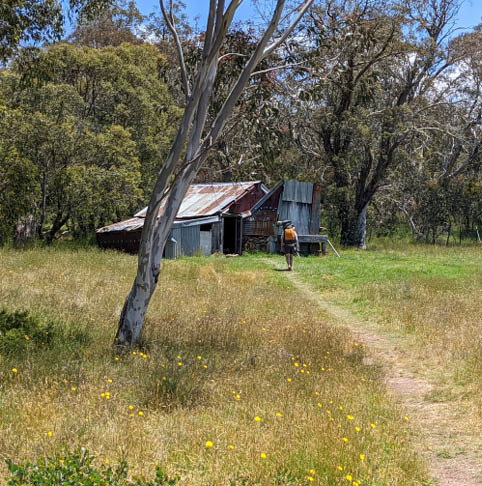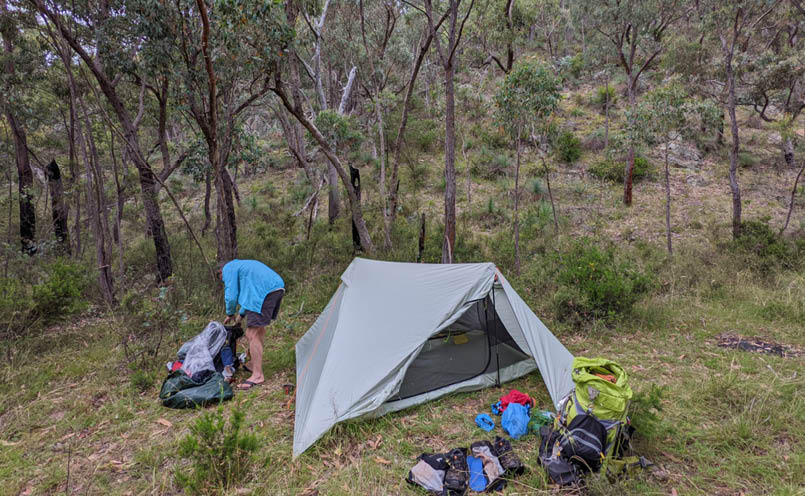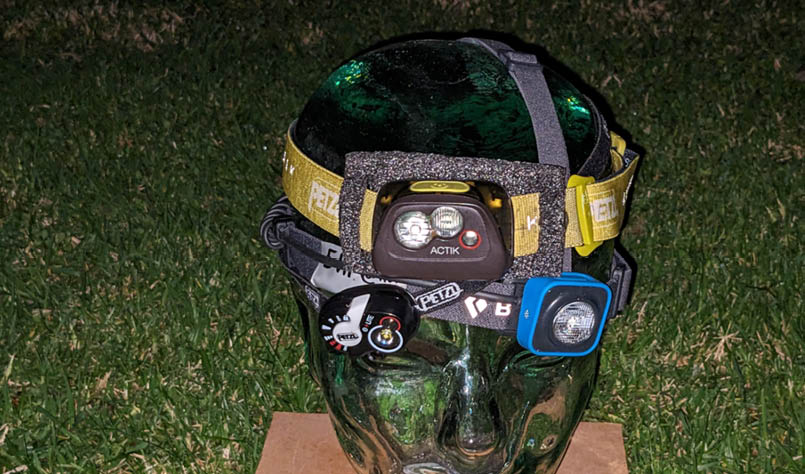Kelly Hut, McMillans Track, Victoria


Tent and Sleeping Gear
Text and photosTerry Cornall
I give lots of links to gear in this article. All of it is unsponsored and all of it is stuff I've either purchased or considered purchasing. You should be able to tell from context. Any recommendations (or damnations) I make should be considered in the lights of your own needs and not taken as gospel.

50 | Bushwalk June 2024
I make plenty of opinionated assertions in this article too, born out of experience and consideration. If you disagree, feel free to drop me a line with new evidence for me to consider. Just telling me that I am an opinionated, arrogant, grumpy old man, whilst true, will not further the discussion. I'd love to discover that my cynical disdain for gear manufacturers' claims is wrong, for example and that there really is a perfect waterproof but breathable boot or raincoat out there.
Tentage
Gordon has this lovely light two-man tent. X-Mid 2P Tent designed by Dan Durston. It is lightweight but needs hiking poles to keep it up, and it does have a fairly big footprint. It works well in rain and moderate wind, and has two generous vestibules and doors. So I took my Black Diamond Carbon Distance Z poles (more on them later) to use one for one side, and Gordon carried a telescopic hiking pole for the other support. Worked a treat.
Things that go bang in the night
Sleeping mats are essential to keep you warm and comfortable, although Gordon once found me asleep in the tent with my Neo Air mattress newly inflated but not yet tucked under me. I was too tired to do it and had nodded off with it still sitting on top of me...
And they are not supposed to go bang, but that's exactly what Gordon's Thermarest Neo Air did, and not just once. On multiple occasions it let out a loud pop when yet another one of its internal baffles let loose, and he ended up with a herniated foot-end
"
And they are not supposed to go bang, but that's exactly what Gordon's Thermarest Neo Air did, and not just once.


Tent at Carey Creek, McMillans Track, Victoria

51
on the thing with the bottom 6 baffles gone. Fortunately, it didn't break any external seams and deflate, so he was able to operate on it and tie off the foot end, leaving it inflatable and useable. No doubt messages will be sent to Thermarest regarding warranties...
There are lots of choices regarding mats, from lightweight, cheap and reliable closed-cell foam to luxurious (but weighty and bulky) down-filled air mats. They vary in comfort, packed volume, cost and weight, naturally. I like the Neo Air by Thermarest (at least the ones that don't go bang) because they are very light, pack into a small-ish volume, and work on snow as well as on tussocky grass and moderately rocky surfaces.
However, it would be wise to think about what happens if they fail on a long trip. The closed-cell ones are light and cheap, can't really 'fail' (other than being less comfortable), but they don't pack well because they are incompressible. By the way, if you use one and hang it naked on the outside of your pack, don't be surprised if it gets shredded at the edges by the bush. Put it in a tough bag to stop that.
Light 'em up
Torches. I got this a bit wrong, by being overly careful. I took two main torches, both rechargeable, plus a spare battery for one of them. In the middle of the hike at a resupply spot, I ditched a torch and the spare battery into a drop-barrel to be retrieved later.
Gordon just took a tiny little Petzl headlamp that ran on lithium button cells. Mainly for reading. Probably weighed in at a poofteenth of nothing (10g maybe), whereas my collection would have come to twenty times that at least.
"
However, it would be wise to think about what happens if they fail on a long trip.




Torches
52 | Bushwalk June 2024
My reasoning was: What happens if we have to pathfind at night? What happens if a torch gets left on and flattens its battery? What if the electronics or batteries fail? All good questions and critical in certain circumstances, like alpine climbing or other situations where you can't really camp just anywhere and have to make it to the next campsite or perish. However, in summer, when daylight is plentiful, where being caught out in the dark isn't going to kill you, perhaps a single torch (especially if reliable and rechargeable and you are carrying a charger) is sufficient.
Clothing maketh the man
Clothing was something I got wrong this time, too. As well as mandatory hiking shorts and tee shirt (or a quick drying long sleeved shirt like Gordon took would have been better) and down puffy jacket for night-times and secondary use as a pillow, I thought I'd need an extra jacket and trousers, as well as thermals to sleep in. I tossed in the down booties as well. They are light and, on a really cold night, very comfy. So far, so reasonable. Then I wore a tracksuit for the drive up to the start and didn't want to leave it in Heather's car, so I took that too. OK, so an unplanned change of warm clothes, so what? I'd appreciate it if it got a bit wettish. Except that I didn't realise it weighed 700g. I've been forced to become a gram-weeny in my dotage and that much extra would have horrified me. The very first night at Black Sallee Lake seemed to justify my choices as it was cold enough for the down booties and thermals under the summer sleeping bag. However, in the end, I only used them that one time and at the halfway point, I was happy to stuff about a kilo and a half of unnecessary clothes into a drop-barrel for later retrieval. (Actually, on a
wet night a few days later, after my raincoat had left me a bit dampish, I would have liked to have had that spare dry jacket...).
Forty days and forty nights, it rained
Speaking of raincoats, I got that wrong, too. I have a range of coats, from a heavy-duty 3-layer Gore-Tex monster, good for blasting Antarctic blizzards, down to ultralight things for running that might stop a shower, maybe. In the middle, there was the choice between a long Torrent jacket from One Planet and a shorter Gore-Tex jacket from Kathmandu. (Model unknown, but it had waterproof zips, pit zips, high pockets that are good when wearing a pack, nice hood, etc. and a 'Guaranteed to keep you dry' label. Clearly designed for this purpose, so I thought...). The Kathmandu one was a few hundred grams lighter, so I chose to take that. It was a mistake. One morning of bashing through the wet bush and hours upon hours of drizzle, and the 'Guaranteed to keep you dry' Kathmandu jacket proved inadequate. Not cold and saturated or anything, but definitely on the dampish side. And before you start down on the 'but you sweated inside it' path, no, it was only a 16 degree Celsius day, and I was not hot enough to sweat much. Mind you, if I had, the jacket fabric had well and truly 'wetted out' (the so-called durable water-proofing treatment had lasted all of 1/2 an hour), so the sweat would have had a hard time getting out. I'll keep it for day trips or bike riding from now on, not serious stuff like this. I think the (obvious in retrospect) moral of the story is to take the raincoat you'd rather use in a bad situation and not the one you'd rather carry if everything goes perfectly.
About bush-bashing in the wet. I forbore to take waterproof trousers, so naturally, my shorts got saturated when pushing through soggy bushes. No biggie, they dried out quickly, but I was envious of Gordon's rain
"
What happens if we have to pathfind at night? What happens if a torch gets left on and flattens its battery? What if the electronics or batteries fail?


"
... 'Guaranteed to keep you dry' label. Clearly designed for this purpose, so I thought...


53